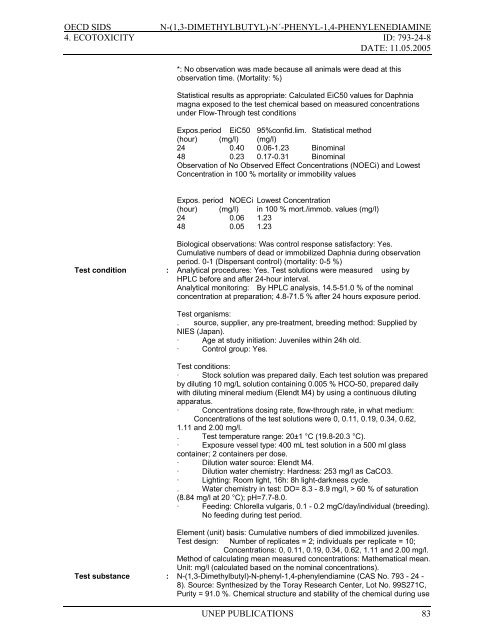N-(1,3-Dimethylbutyl)-N
N-(1,3-Dimethylbutyl)-N
N-(1,3-Dimethylbutyl)-N
You also want an ePaper? Increase the reach of your titles
YUMPU automatically turns print PDFs into web optimized ePapers that Google loves.
OECD SIDS<br />
N-(1,3-DIMETHYLBUTYL)-N´-PHENYL-1,4-PHENYLENEDIAMINE<br />
4. ECOTOXICITY ID: 793-24-8<br />
DATE: 11.05.2005<br />
*: No observation was made because all animals were dead at this<br />
observation time. (Mortality: %)<br />
Statistical results as appropriate: Calculated EiC50 values for Daphnia<br />
magna exposed to the test chemical based on measured concentrations<br />
under Flow-Through test conditions<br />
Expos.period EiC50 95%confid.lim. Statistical method<br />
(hour) (mg/l) (mg/l)<br />
24 0.40 0.06-1.23 Binominal<br />
48 0.23 0.17-0.31 Binominal<br />
Observation of No Observed Effect Concentrations (NOECi) and Lowest<br />
Concentration in 100 % mortality or immobility values<br />
Expos. period NOECi Lowest Concentration<br />
(hour) (mg/l) in 100 % mort./immob. values (mg/l)<br />
24 0.06 1.23<br />
48 0.05 1.23<br />
Biological observations: Was control response satisfactory: Yes.<br />
Cumulative numbers of dead or immobilized Daphnia during observation<br />
period. 0-1 (Dispersant control) (mortality: 0-5 %)<br />
Test condition : Analytical procedures: Yes. Test solutions were measured using by<br />
HPLC before and after 24-hour interval.<br />
Analytical monitoring: By HPLC analysis, 14.5-51.0 % of the nominal<br />
concentration at preparation; 4.8-71.5 % after 24 hours exposure period.<br />
Test organisms:<br />
. source, supplier, any pre-treatment, breeding method: Supplied by<br />
NIES (Japan).<br />
· Age at study initiation: Juveniles within 24h old.<br />
· Control group: Yes.<br />
Test conditions:<br />
· Stock solution was prepared daily. Each test solution was prepared<br />
by diluting 10 mg/L solution containing 0.005 % HCO-50, prepared daily<br />
with diluting mineral medium (Elendt M4) by using a continuous diluting<br />
apparatus.<br />
· Concentrations dosing rate, flow-through rate, in what medium:<br />
Concentrations of the test solutions were 0, 0.11, 0.19, 0.34, 0.62,<br />
1.11 and 2.00 mg/l.<br />
. Test temperature range: 20±1 °C (19.8-20.3 °C).<br />
· Exposure vessel type: 400 mL test solution in a 500 ml glass<br />
container; 2 containers per dose.<br />
· Dilution water source: Elendt M4.<br />
· Dilution water chemistry: Hardness: 253 mg/l as CaCO3.<br />
· Lighting: Room light, 16h: 8h light-darkness cycle.<br />
. Water chemistry in test: DO= 8.3 - 8.9 mg/l, > 60 % of saturation<br />
(8.84 mg/l at 20 °C); pH=7.7-8.0.<br />
· Feeding: Chlorella vulgaris, 0.1 - 0.2 mgC/day/individual (breeding).<br />
No feeding during test period.<br />
Element (unit) basis: Cumulative numbers of died immobilized juveniles.<br />
Test design: Number of replicates = 2; individuals per replicate = 10;<br />
Concentrations: 0, 0.11, 0.19, 0.34, 0.62, 1.11 and 2.00 mg/l.<br />
Method of calculating mean measured concentrations: Mathematical mean.<br />
Unit: mg/l (calculated based on the nominal concentrations).<br />
Test substance : N-(1,3-<strong>Dimethylbutyl</strong>)-N-phenyl-1,4-phenylendiamine (CAS No. 793 - 24 -<br />
8). Source: Synthesized by the Toray Research Center, Lot No. 99S271C,<br />
Purity = 91.0 %. Chemical structure and stability of the chemical during use<br />
UNEP PUBLICATIONS 83
















